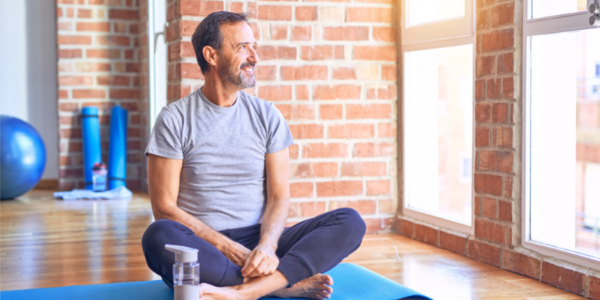While we all want to remain agile and fit the fact is, our bodies and athletic abilities change as we approach middle age and some of our old go-to exercises can put unnecessary strain on our joints and cause discomfort. Thus, finding an exercise routine we can enjoy without causing damaging to our aging joints and muscles can be difficult. However, yoga offers just such an opportunity.
While yoga may have the reputation for being an intimidating approach to pretzel-like poses done primarily by women, many men are finding the benefits of the total body exercise.
When men get older, they tend to become more sedentary and improving their flexibility is a challenge, but it is not impossible. It’s important to realize that age should never prevent any man from introducing yoga into their life. Yoga for men can incorporate basic postures without all the fancy balancing acts, and is an effective way to maintain regular exercise, provide men with a foundation of flexibility and strength, and allow them to experience the many health benefits it provides.
The Basics and Benefits
When men over 40 participate in yoga, the movements can be very effective. Holding a pose for many breaths results in connective tissues and muscles loosening and relaxing, which can help build overall strength and stamina and can also help men improve their overall health.

Yoga is a type of resistance training. It improves a person’s muscle tone as well as strength. Men over 40 who practice regularly, tend to find that they become more flexible and have better balance as a result of yoga. Doing yoga also helps to maintain bone strength and muscle mass – a struggle for many who are dealing with andropause. Unlike traditional bodyweight exercises, the tension on your muscles during a yoga practice is always present due to holding a yoga pose for extended breaths. Because of this, yoga can help you gain muscle mass by testing your endurance limits and breaking down muscle fibers, so that the body can build them back up.
Since no weight is added, the likelihood of injury is significantly decreased, and there are a variety of poses that can work on different parts of the body.
The physical activity of yoga can help maintain mental sharpness as a person ages. When men over 40 do yoga, it improves their flexibility, strength, and balance but these are only accomplished to the full extent by focusing the mind. Doing this will provide short and long-term benefits. Research has shown that a person’s brain speed and accuracy, as well as mood, can all improve when yoga is done regularly.
As people age, maintaining their bone health can become a challenge. Bones are living tissue and a person’s body is regularly breaking it down and building it up. As they age, it is natural for men to experience some bone loss or bone density due to aging. Yoga may help with maintaining bone health. Research has shown that if yoga is done properly and regularly, it can help improve flexibility and balance, thus strengthening the body and removing risk factors to falls and fractures.
Yoga can be used as an effective way to lose weight with simple practices. To gain weight loss benefits, it’s not necessary to do hot yoga or double up on the super bendy stretches in a yoga pose. Improvement to the metabolic system in men over 40 can happen with gentle yoga exercises done consistently and properly. Yoga can help men achieve and maintain a normal weight by doing the poses that help restore a person’s hormonal balance.
When a man over 40 is struggling with rehabilitation after health concerns, surgery or is recovering from an injury, yoga can be a good way to assist the recovery process. Yoga can also help men over 40 experience increased protection against future injuries by stretching and strengthening the body’s muscles and improving blood flow. By identifying unseen issues during practices yoga can help prevent issues from developing into long-term or chronic health problems.
Research has shown that yoga is a very effective exercise for experiencing pain relief. This can also include relief from arthritis, fibromyalgia, migraine, low back pain, and many other types of chronic pain conditions. When men over 40 need to experience relief from their back, joints or knee pain, yoga may be able to address surrounding muscles, ligament and circulation issues to alleviate the pain and discomfort.
When yoga is practiced, even for just a few minutes, it is often a sufficient enough time for people to eliminate the fatigue they’re experiencing from their day. Thus, yoga can help increase the energy of aging adults to help them handle their busy life and leave them feeling refreshed for a longer time. The daily practice of yoga is at the center of feeling good and having more than enough energy every day and certain yoga poses are designed to provide extra energy and distribute energy throughout the body.
Five Beginner Yoga Poses for Men Over 40
Benefits: Strengthens the knees and legs. Stretches hips, hamstrings, and calves. Can help reduce anxiety and fatigue. Relieves tension in the spine and neck.
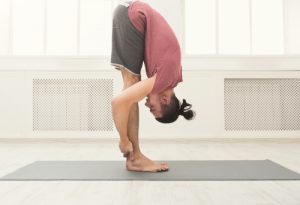
Benefits: Stretches the legs and upper arms. Helps open the hips. Can boost energy. Strengthens the lower and upper body. Improves circulation.
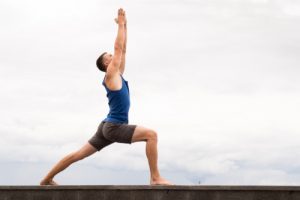
Benefits: Stretches the whole body; legs, arms, shoulders, spine, and abdomen. Helps with stress relief. Stimulate blood circulation.
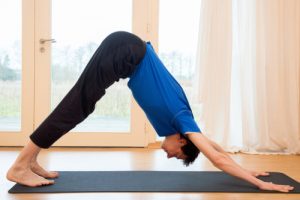
Benefits: Improves posture and balance. Strengthens and stretches the spine, neck and abdomen. Relieves stress. Strengthens the abs and core stability. Builds greater range of motion.
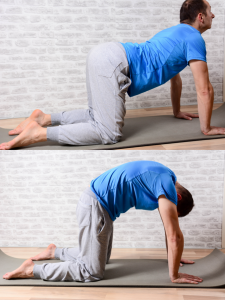
Benefits: Stretches chest and shoulders. Strengthens ankles, thighs, hips, and calves. Tones leg muscles.
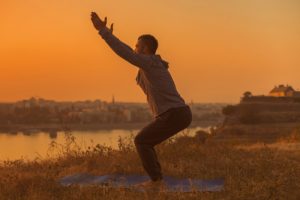
Over time you will find that the daily practice of yoga will allow you to reach deeper into poses and hold them for longer lengths of time with greater ease. Regular practice will also help contribute to men’s overall fitness and help protect them from a variety of different health issues.
Like all physical fitness activities, it is important to be mindful of the body and not push into a pose that causes pain or intense discomfort, and if medical limitations are a concern, be sure to consult with your doctor before beginning a new yoga practice.
